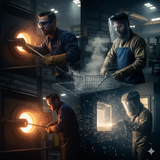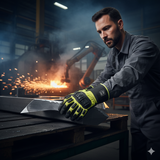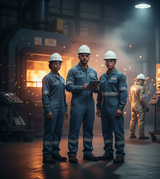Seeing Clearly: A Comprehensive Guide to Workplace Eye Protection
n the bustling environments of industrial sites, workshops, laboratories, and even offices, our eyes are constantly exposed to potential hazards. From flying debris and chemical splashes to harmful radiation and intense light, workplace eye injuries are alarmingly common – and overwhelmingly preventable. Losing vision, even partially, can be life-altering, highlighting why proper eye protection isn't just a recommendation; it's a critical necessity.
At Your Safety Company, we understand that clear vision is paramount to safety and productivity. Let's delve into the world of workplace eye protection to help you make informed choices for your team.
The Hidden Dangers to Your Eyes
Your eyes are incredibly delicate and vulnerable to a multitude of workplace hazards:
-
Impact: Flying objects (metal shards, wood splinters, dust, concrete), tools, or equipment.
-
Chemical Splash: Acids, bases, solvents, cleaning agents, and other corrosive liquids.
-
Dust & Fine Particles: Sawdust, grinding dust, concrete dust, and other airborne particulates.
-
Heat & Radiant Energy: Intense light from welding arcs, furnaces, molten metal, or laser operations.
-
Optical Radiation: Ultraviolet (UV), infrared (IR), and visible light from specific processes like welding or cutting.
Types of Eye and Face Protection: Your Shields
Not all eye protection is created equal. Choosing the right type depends on the specific hazards present:
-
Safety Glasses:
-
Purpose: Your first line of defense against moderate impact hazards, flying particles, and some UV radiation.
-
Features: Stronger frames and lenses than regular eyeglasses, often made from polycarbonate, which is highly impact-resistant. Available with various lens coatings (anti-scratch, anti-fog, anti-glare) and tints (clear, indoor/outdoor, shaded).
-
Prescription Safety Glasses: Ensure workers who need corrective lenses have proper safety eyewear.
-
-
Safety Goggles:
-
Purpose: Provide a tighter seal around the eyes, offering superior protection against dust, chemical splashes, and fine particles that safety glasses might not block.
-
Features: Available with direct or indirect ventilation (indirect is better for splash protection) and various lens types. Often worn over prescription glasses.
-
-
Face Shields:
-
Purpose: Offer full-face protection against large flying objects, sparks, spatter, and chemical splashes.
-
Important Note: Face shields must always be worn over primary eye protection (safety glasses or goggles) as they do not provide primary impact or chemical splash protection alone.
-
-
Welding Helmets:
-
Purpose: Essential for protecting the eyes and face from the intense light, UV/IR radiation, and sparks generated during welding.
-
Features: Auto-darkening lenses are highly popular, automatically adjusting to the arc's brightness.
-
-
Specialty Eyewear:
-
For specific hazards like laser operations, specialized laser safety glasses with specific optical density ratings are required.
-
Choosing the Right Protection: The ANSI Z87.1 Standard
The gold standard for eye and face protection in the US is the ANSI Z87.1 standard. Always look for this marking on your eyewear to ensure it meets rigorous safety requirements.
-
"Z87+" (Impact Rated): Indicates high-mass and high-velocity impact protection.
-
"D3" or "D4" (Liquid Splash/Dust): For protection against liquids (droplets/splash) or dust.
-
"U" (UV Filter), "L" (Visible Light), "R" (Infrared), "W" (Welding Shade): Specific filter ratings for radiant energy.
Beyond standards, consider:
-
Hazard Assessment: What specific risks are present in your workplace? This is the starting point for selection.
-
Fit and Comfort: Eyewear must fit securely without being uncomfortable, or employees won't wear it consistently. Look for adjustable features.
-
Visibility: Ensure the lens provides clear, distortion-free vision and doesn't hinder peripheral sight.
Proper Use, Care, and Maintenance
Even the best eye protection won't work if it's not used or maintained correctly:
-
Wear It Consistently: Eye protection should be worn whenever there's a risk of eye injury, not just during active operations.
-
Clean Regularly: Use mild soap and water or manufacturer-approved cleaning solutions. Avoid abrasive materials that can scratch lenses.
-
Inspect Before Each Use: Check for scratches, cracks, bent frames, or damaged straps. Compromised eyewear must be replaced immediately.
-
Store Properly: Keep eyewear in a clean, protective case when not in use to prevent damage.
Protect Your Vision, Protect Your Future
Workplace eye injuries are largely preventable. By understanding the hazards, selecting the appropriate ANSI-compliant protection, ensuring proper fit, and maintaining your gear, you empower your workforce to perform their duties safely and confidently. It's an investment that pays dividends in health, productivity, and peace of mind.
Don't leave your vision to chance. Explore our comprehensive selection of high-quality safety glasses, goggles, face shields, and welding helmets designed for every industry and hazard at Your Safety Company. See clearly, work safely!
Recent Posts
-
More Than Goggles: The Specialized Eye Protection Needed for High-Heat Industrial Environments
In facilities that process metal at extreme temperatures, eye safety is a complex, multi-layered cha …12th Nov 2025 -
Double Defense: Why Cut and Impact Protection is Critical for Material Handling
In facilities that deal with heavy metal parts, sharp edges, and complex machining, a standard work …11th Nov 2025 -
Beyond the Flame: Why NFPA 2112 FR Apparel is Non-Negotiable
In high-risk industrial settings—from petrochemical plants and utilities to metal processing and hea …7th Nov 2025



